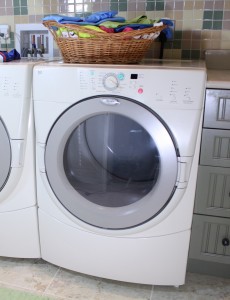30 December 2015
Appliance upgrades that save the most water, energy and cost
Posted by Lauren Lipuma
According to a new study, not all appliance upgrades are financial or energy-saving bargains
by Alison F. Takemura

Upgrading to an Energy Star clothes dryer won’t save as much energy as switching out windows, according to new research.
Credit: Rickharp via Wikimedia Commons
A busy American home hums on its appliances. They wash our clothes, heat our rooms and chill our pudding. But they also guzzle energy, water and dollars. Now, a new analysis helps consumers choose which appliances to swap for more efficient models and save money in the process, with some surprising results. Best buys include the furnace and water heater, rather than the more visible clothes dryer and refrigerator, the researchers found.
The new study, presented at the 2015 American Geophysical Union Fall Meeting, accounted for both the energy and water an appliance uses in its lifetime, even when those costs are intertwined or hidden. A washing machine, for example, sloshes clothes in water and cleans them with energy. But it also takes energy to make that water potable again.
On the flip side, making energy also costs water. Water helps extract or purify fossil fuels like natural gas. And as steam, water powers turbines to generate electricity. That steam is considered consumed because it gets lost to the atmosphere, no longer available to locally use.
“Electricity has water associated with it, even though it isn’t wet,” said Ashlynn Stillwell, an engineering professor at the University of Illinois at Urbana-Champaign and principal investigator of the study.
Upgrading appliances can save water, energy and, in the long term, money. To help consumers choose more efficient machines, the Environmental Protection Agency’s Energy Star and WaterSense programs label appliances that meet efficiency standards. The options abound, such as low-flow toilets, high efficiency refrigerators, clothes dryers and furnaces.
To find out which appliance upgrades make the most difference, Stillwell and her colleagues collected publicly available data on how much energy and water the average U.S. household consumes, both in the home and outside it. They then pretended to switch conventional appliances to 14 Energy Star and five WaterSense equivalents and kept track of the cost.
The analysis revealed that the right combination of appliances — such as efficient faucets, windows and furnaces — could cut a home’s energy cost by about 40 percent with no net loss of money. If water savings were paramount, switching to a different but overlapping combination of machines — such as a furnace, water heater, and faucets — could save up to 30 percent of a household’s annual water use, according to the study.
Stillwell said she was surprised by some of the outcomes. One of the best appliances to update for water efficiency was the gas furnace, not the more intuitive shower head or dishwasher, because of the water associated with producing the energy, she explained. In addition, windows have more potential than a clothes dryer to save energy and money, she said. And swapping out a refrigerator was a dud: the research showed that a refrigerator would never recoup its cost and would only ding the energy footprint, saving less than a seventh of the energy an efficient gas water heater would conserve.
By linking lifetime cost, energy, and water efficiency, the team showed which appliances give the greatest returns.
“We created a way of thinking about [energy and water efficiency] in terms of cost effectiveness,” Stillwell said.
The team hopes to use their findings to inform consumers. “I would love to see this publicly available as an interactive website,” Stillwell said.
She imagines a site where consumers could enter where they live and what their bills say, and some behind-the-scenes code could create a custom profile of the home appliance upgrades that would be right for them.
– Alison F. Takemura is a science communication graduate student at UC Santa Cruz. You can follow her on twitter @AlisonTakemura.



 GeoSpace is a blog on Earth and space science, managed by AGU’s Public Information staff. The blog features posts by AGU writers and guest contributors on all sorts of relevant science topics, but with a focus on new research and geo and space sciences-related stories that are currently in the news.
GeoSpace is a blog on Earth and space science, managed by AGU’s Public Information staff. The blog features posts by AGU writers and guest contributors on all sorts of relevant science topics, but with a focus on new research and geo and space sciences-related stories that are currently in the news.